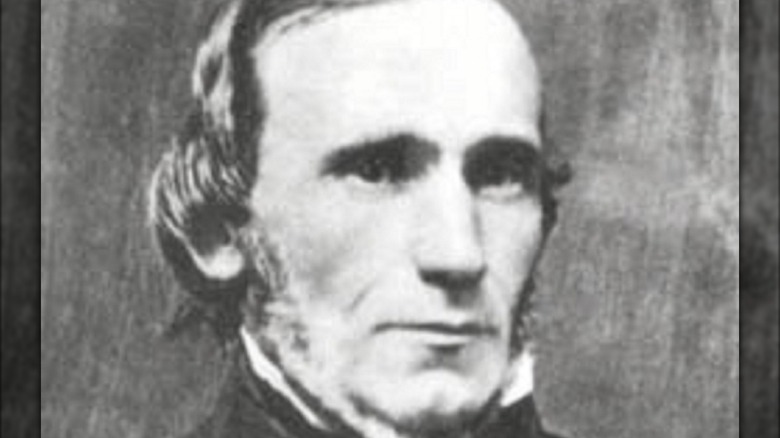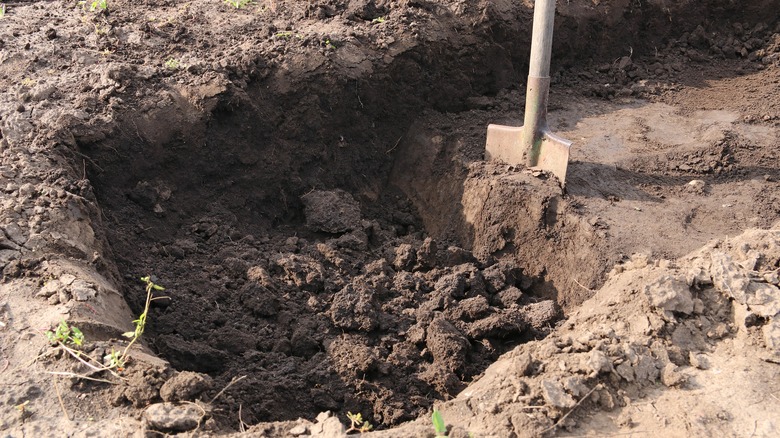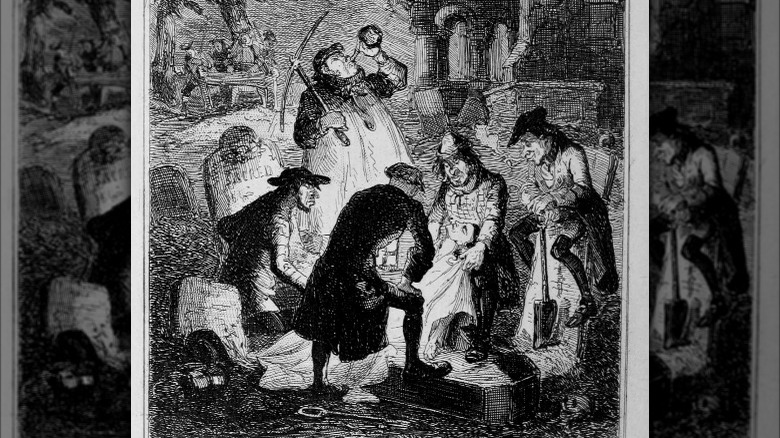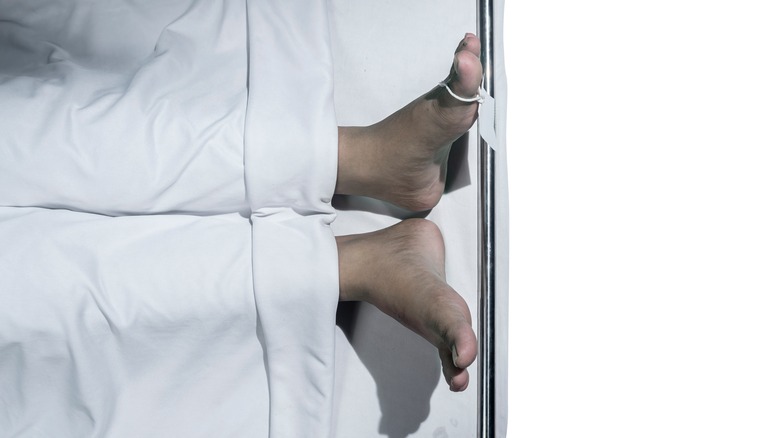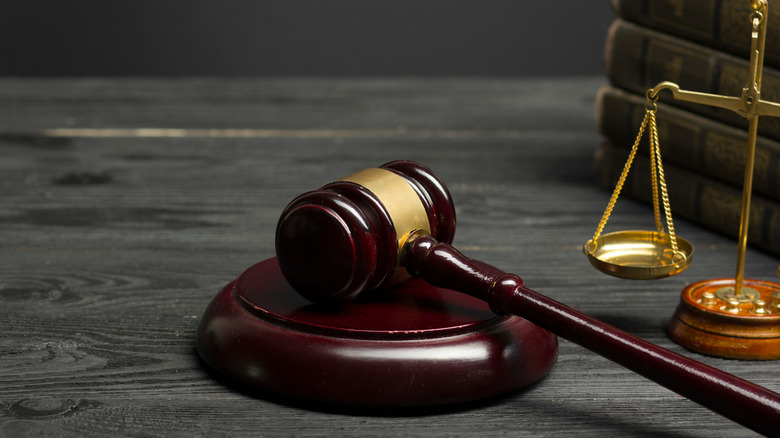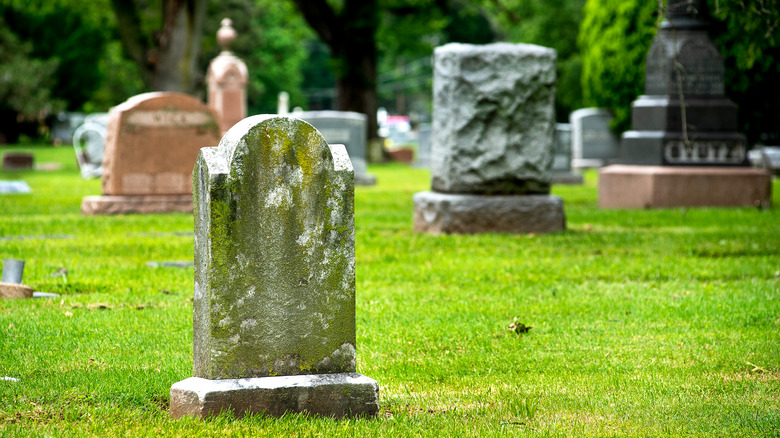The True-Life Grave Robbery Of A US Congressman Is Stranger Than Fiction
In the 1800s, grave robbery — also known as body-snatching — was a common occurrence. Despite being illegal, robbers scoured cemeteries for fresh corpses to sell, and it was a way to get large sums of money, especially for the poor. One of the victims of a grave robbery was John Scott Harrison, an Ohio farmer who was also a member of the House of Representatives.
Apart from being known as a politician, Harrison was also the only person to be the son and father of U.S. presidents. His father was William Henry Harrison, the 9th president of the country, and his son was Benjamin Harrison, who served as the 23rd president of the U.S. On May 25, 1878, John died in his sleep at the age of 73 years old. Fearful that his corpse would be snatched by grave robbers, his family had stone slabs placed on top of his casket (via Benjamin Harrison Presidential Site). In addition, his sons paid a watchman to guard their father's gravesite for a duration of a month after the burial ceremony.
Augustus Devin's missing body
John Scott Harrison was buried in North Bend, Ohio, on May 29, 1878. Just a week before his death, he attended the burial of a distant relative named Augustus Devin who died of tuberculosis at just 23 years old. He was buried near the location of John's grave. During John's burial, as reported by Mental Floss, his family observed that Devin's grave looked like it had been disturbed. Upon inspection, Devin's body wasn't in its place. John's sons made it their mission to locate the body and bring it back to its rightful location.
The following day, the Cincinnati Enquirer daily newspaper published a report that "something white" was taken out from a buggy that was parked by the Medical College of Ohio. One of John's sons, John Jr., and his cousin George Eaton secured a search warrant to look for Devin's body in six medical schools in the area in hopes that they would find Devin's remains there, and one of the schools they checked was the Medical College of Ohio.
The resurrectionists
In the 1800s, more and more medical schools were established in the United States as the study of surgery and anatomy became more prevalent. At the beginning of the 1800s, the U.S. only had four medical schools, but that number rose to more than 160 by 1900, as reported by The History Guy. Body snatching, however, dated back to the 1700s and even sparked the 1788 Doctors' Riot in New York. It was reported that medical students had resorted to robbing graves to use the corpses for practicing dissection (via Smithsonian Magazine). As the news spread, the community rioted in the streets of New York and protested against the disrespectful means used to acquire bodies.
As the number of medical colleges increased, the demand for cadavers went up as well. Body snatchers — known as resurrectionists — sold fresh corpses to medical schools. Per Cemetery Index, they scoured cemeteries for newly-buried bodies, as they were easier to dig. Upon delivery to medical schools, it was common practice for medical students to remove some of the parts of the corpse to prevent identification in case authorities searched the facility. Although grave robbery was illegal, those caught were only charged with a misdemeanor. Authorities did not agree with stealing corpses, but they also knew that the bodies were being used to improve medical practices.
John Scott Harrison's body
John Harrison Jr. and George Eaton were accompanied by local authorities, and they went to the Medical College of Ohio where they were met by janitor A.Q. Marshall. According to Mental Floss, the group saw human body parts, the body of an infant, and medical students working, but they didn't see Augustus Devin's corpse. Marshall said he would bring the men to a faculty member of the school, and they were brought to a room where they noticed rope that went through a hole in the floor.
Authorities inspected the contraption, and they realized that it was a pulley system that was used to lift corpses to different levels of the school. The rope was taut and it was determined that a body was secured to it. Authorities pulled up the rope and a dead body covered with cloth was revealed. Both John Jr. and Eaton said that the corpse seemed too old to be that of Devin's, but authorities checked nonetheless (via Benjamin Harrison Presidential Site). When the cloth was removed, John Jr. was shocked at what he saw. It was the body of his father, John Scott Harrison, who was buried just the day prior.
News of the grave robbery
Even before John Harrison Jr. notified his family of his distressing discovery, they already knew that someone had taken John Scott Harrison's corpse. Some relatives visited the gravesite and saw the body missing despite the measures the family put in place to prevent resurrectionists from stealing it. The Harrison brothers were livid. Benjamin Harrison openly criticized the medical school and filed a civil lawsuit against them, as reported by Cincinnati Magazine. News of the incident headlined newspapers, and janitor A.Q. Marshall was arrested, but the medical school paid his bond which amounted to $5,000.
Citizens of Cincinnati were outraged upon learning that Marshall was released, and they formulated a plan to take action against the Medical College of Ohio. Benjamin, however, declined the proposition and said there was no concrete evidence to prove they knew they had his father's body, but he was convinced that school officials were covering for the ones responsible for the grave robbery, per the Benjamin Harrison Presidential Site.
The aftermath of the incident
The Harrison family had the body of John Scott Harrison temporarily placed in the vault of a close friend of the Harrison family before it was re-interred at the Harrison family plot. Harrison's grave robbery sparked changes in the Anatomy Acts. Punishment for the crime of grave robbing was increased, and medical schools were also given authority to use the bodies of prisoners and orphans for medical practice if they were left unclaimed. Eventually, medical professors were discovered to have had contracts with resurrectionists to provide them with a constant supply of dead bodies.
The Harrison brothers didn't give up looking for the body of Augustus Devin. Other medical schools in Cincinnati were searched, but the young man's corpse was nowhere to be found. Three weeks later, however, authorities were given information that would eventually lead them to the University of Michigan where Devin's body was found, per the Benjamin Harrison Presidential Site.
